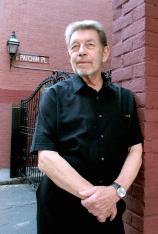Downtown: My Manhattan
Review
Downtown: My Manhattan
For anybody who was born there or grew up in its immense shadow, there can be, no matter how far away you travel in life, only one place forever known as "The City."
And that city is the real life Oz known as New York. Bestselling author and journalist Pete Hamill knows this city well. He was born in Brooklyn and has spent the last four-plus decades exploring the streets of New York as both a newspaperman and resident.
DOWNTOWN: My Manhattan, is Hamill's brilliant tribute to the city he loves. It is part history, part memoir, and part elegy.
The book follows the growth of Manhattan from its roots as a Dutch trading post on the lower tip of the island to its inevitable expansion uptown to Times Square and upwards to the sky.
The geographic scope of this book is no accident. It mirrors the area where Hamill has paid rent on 14 different apartments over the years and where he now lives. On these streets, he tells us, "I am always a young man."
Besides being one of America's most famous journalists, Hamill is also one of our greatest living writers. He is a master of the craft. He brings to this book both the journalist's eye for detail and the poet's gift for language. The writing is sharp and clear, and as tough as a street vendor on Canal Street during lunch hour.
There is much here to delight the reader. Hamill reveals little known aspects of the city's history, from the first Dutch colonial governor, who was also the first to cook the city's books, to British Governor Lord Cornbury, who enjoyed strolling around in drag after 1702 and once had himself painted as Queen Anne.
But we also learn how an African American named Master Juba joined with an Irish American named John Diamond in 1844 to create tap dancing. And then there is the first Broadway musical in 1866, which prompted 31-year-old Marc Twain to exclaim: "the scenery and the legs are everything."
Hamill introduces us to a city where "the present becomes the past more rapidly than in any other world city." This is a place where the velocity of change is so great that it seems the entire city is rebuilt every ten years. But there are still many wonderful places you can visit today, such as Trinity Church in lower Manhattan, which, he explains, "asserts a sense of pheonixlike triumph, rebirth and enduring faith" while nestled among skyscrapers.
The engine for this perpetual growth has been the immigrants, who still arrive daily in search of a better future. Hamill tells us the great enduring gift that the Dutch gave New York was tolerance. For New York was a city built on pragmatic concerns; commerce, not religion or political ideology, ruled its history. The only true religion of New York, we learn, is real estate.
New York is a city that should not work. Today there are more than 100 languages spoken on its streets, including at least 10 dialects of Chinese. But it does work because, despite its fair share of crooks and scoundrels and disasters, the tradition of tolerance holds.
Each new generation of immigrants becomes part of the alloy on New York. Lower East Side settlement houses that once helped Jewish immigrants now provide aid to Latinos and Asians.
The immigrants also brought with them nostalgia, which would become the one thing permanent here. Hamill calls New York "the capital of nostalgia." The immigrants endured a double dose of it. They felt the loss of the land of their birth. But as they assimilated into America and watched new waves of immigrants transform New York, they carried inside them the memories of the now vanished New York where they once lived and struggled.
All New Yorkers carry this nostalgia. Even after Times Square and 42nd Street were rescued and cleaned up with the help of corporations like Disney in the 1990s, many of us find ourselves missing the old "Deuce" with its edge of danger and forbidden excitement.
In describing this longing for the past, Hamill's writing becomes almost lyrical. On the long lost and much missed old Penn Station, he writes, "For generations, young men had waited near the clock for young women arriving for a night together on the town. I was one of them. We could look at the ruins of the station and remember girls in polo coats with snow melting in their hair…We could remember a time when we were so young that we thought the things we loved would last forever."
What lasts forever is New York. This book is essential reading for anyone who wants to understand this great city or is planning a visit.
Follow Hamill down these streets and into the parks. Stop and look up at the marvelous Beaux-Arts buildings that now house Starbucks and Kinkos on their ground floors. Stand in Grand Central Terminal during rush hour and feel the energy flowing around you. Gaze out at New York Harbor from Battery Park and imagine ships filled with immigrant dreams. You will find a magical place that will make you want to live forever.
Reviewed by Tom Callahan on January 21, 2011
Downtown: My Manhattan
- Publication Date: November 8, 2005
- Genres: Nonfiction
- Paperback: 320 pages
- Publisher: Back Bay Books
- ISBN-10: 0316010685
- ISBN-13: 9780316010689





